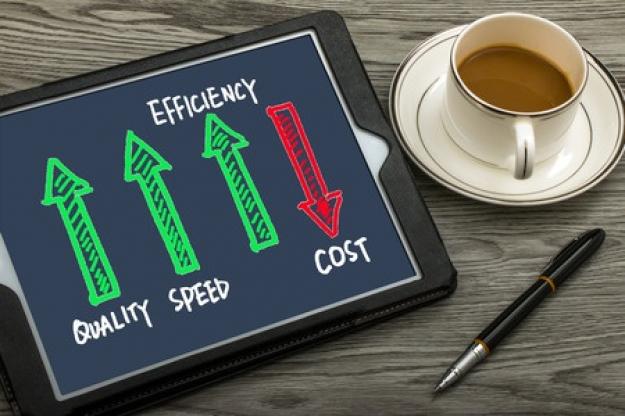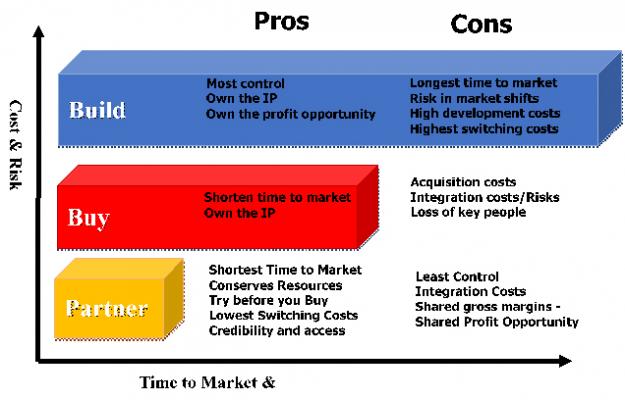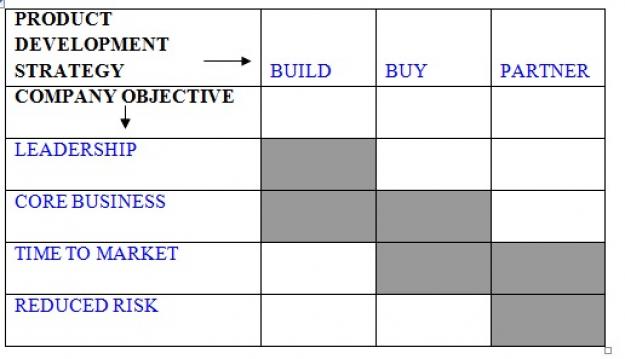Latest News
- Messaging for Product that Locates Lost Medical Devices
(posted: Mar, 2025)Highland is working with a tech solutions company on the messaging for their locator product.
Blog Archives
- Channel Chiefs 6: Scorecarding Ecosystem Health
(posted: Dec, 2017)We frequently talk about our partners collectively as an ecosystem, yet there are many ways to interpret what this means. In this post, we go over how to maintain your ecosystem's health.
- Channel Chief Series Pt.5: Number of Partners
(posted: Nov, 2017)Understanding if you have the right number of channel partners can be a tricky question. This post offers a few key questions that will help you to figure out your optimum partners.
Build, Buy or Partner? The Challenges of Product Management
(posted: March 26th, 2019)
Product marketing, management and development departments have pressure from all sides to add competitive differentiation to product, fill in product line gaps and offer a complete solution to customers.

Product groups have three strategies they can choose from to solve these issues: Build products or components from scratch, buy components, product, product lines or companies, or partner with companies to meet these product development needs.
Companies must always start with the customer to choose their strategies. This article reviews the benefits and trade-offs of each strategy, the objectives to analyze to determine which strategy fits the company's situation and the customer's needs.
The Challenges of Product Management:
"We need to socially enable our product."
"We need security features to be competitive."
"We need a whole product solution; not point products."
"My customer won't buy unless we have a SaaS option."
"The product needs an analytical tool."
"We need it now!"
These are the realities and challenges of product marketing, management and development in a rapidly changing environment. Product developers and managers hear all of these demands and more. Customers demand enhancements; management wants innovative solutions to establish technological leadership and dominate the market; competitors are making inroads in share of market. And time is of the essence!
The critical issue product marketers and managers face is to choose the appropriate product development strategy to follow. Product development and management organizations have three choices:
- Build proprietary technology and products
- Buy components or entire products or product lines or even companies
- Partner with organizations to build or resell existing products
Benefits and Trade-offs
The strategy choice depends on a mix of business objectives, market demands and financial considerations. Each option offers a trade-off between risks and rewards.
Build Decision
Building is defined as in-house development. Building a product internally allows the most control over the attributes and architecture of the end product and allows a company to own the intellectual property.
Keeping control over the go-to-market strategy and product positioning is another benefit. Finally, because product development is completely internal to the company and all profits remain with the company, this option potentially offers the most profit opportunity.
Conversely, choosing to build a new product internally can be riskier, especially in fast moving markets. It usually means a longer time to market, increasing exposure to competitive risks or that customer preferences may shift before the product is ready to launch.
This choice also carries the highest development costs and highest switching costs (if market or competitive scenarios change, the cost to switch to a different product development scheme is highest of all options).
Companies whose core business strategy is technology leadership usually choose to build products internally or at most, buy components of the products, but integrate and build the final product. Their innovative concepts are so revolutionary that no other company has what they plan to develop. They must become pioneers, building what they envision. If you are the leader in your field, then there is no one to buy and no one to partner with, so build is your best and only option.
Buy Decision
Buying a product refers to the acquisition of technology or even whole products or companies. This option can significantly shorten the time to market while still providing intellectual property rights and control over the product. While there are costs of acquisition, they may not be higher than product development, and if buying an established product or company, may bring already developed distribution and marketing channels.
Buying a company makes sense when a product/technology is core to the business and ownership of intellectual property is a distinct competitive advantage, yet in-house expertise is not available and time is of the essence. If a company that has already invested time and resources in creating an appropriate technology solution is available for purchase, this can be an ideal way to gain leadership and expertise in the market quickly and cost-effectively. When companies note that the market is starting to grow quickly, buying is the best way to maintain control but enter the market in time.
There are risks to buying a product. While sometimes less expensive than building products, acquisition costs can still be high. Without serious due diligence, the product technology may not be proven or an appropriate solution. Once a product is acquired, integration of the product to ensure it works seamlessly with other products can be costly and time consuming.
There is also a risk of losing key talent in the merger unless there are carefully designed legal provisions to retain the talent and keep them motivated.
Partnering Decision/Resale Decision
A hybrid model is the resale model, which combines aspects of technology acquisition and partnering. In a resale model, a company simply agrees to distribute another company's product using its own sales organization and current channels. The costs and technology risks are much less and switching costs are moderate.
However, there is less control over the product features and architecture and the product may change without notice. Furthermore, vendor terms and processes must be established, the sales force must be trained to sell the product, and a sales support plan and materials must be developed.
Alliance partnering is the low cost, low risk model with potential for the shortest time to market. It may enable a company to be first to market, catching the market as it emerges and grows, thus allowing the company to become the market leader with all the benefits that position brings (market awareness, premium pricing, lower sales costs, analyst attention).
It conserves resources, affords access to needed technology and provides immediate credibility. Switching costs are the lowest. Sales and support can be provided through the company that owns the product, meaning that the other partner company's internal sales department will not have to learn the product in full detail. Finally, because the partner companies remain separate entities, they can test the waters before making any deeper commitments.
However, partnering offers drawbacks. It offers the least control over the product development future. There is the risk that due diligence may fail to uncover issues with the partner company or its products. Finally, the profit opportunity is the lowest of the three options, due to shared gross margins.
Companies that need to respond quickly to market demands for product enhancements or additions that are not core to their business, choose to partner. Partnering makes sense when a company does not need to own the technology to remain competitive. Partnering also allows a company to claim space in a market it may not currently be in or establish a competitive positioning while evaluating the benefits of buying or building.
It may reduce risk, especially if industry standards are in flux and the company is not the standard setter, or when market leaders are not clear, which makes an acquisition bid risky. Finally, when customers in a market buy best of breed solutions, a company may need to partner with competitors to offer a full suite of products that fulfill customer buying preferences and maximize customer satisfaction.
The graphic below shows the benefits and trade-offs of the three options.

Buy, Build or Partner, the pros and cons
Choosing the Correct Strategy
Following an evaluation of the company's business objectives, strategic driving force, market situation, competitive arena, financial needs, customer demands, and stage of product lifecycle, a company determines the most appropriate product development strategy. Many companies use all three strategies at different times and to meet different needs. A decision to partner can often lead to an acquisition, a try before you buy approach.
How to Choose Your Strategy
The choice of product development strategy relates to the relative importance to the organization of the following variables:
- Does the company have leadership?
- What is the core business?
- How important is time to market/speed?
- What is the risk?

Product development strategies
Product development requires that companies use one of the three strategies depending on a variety of variables including the company's strategy, competitive scenarios, product needs, and financial situation.
In summary, companies:
- Build products for technology leadership
- Buy if product is core to business and time is critical
- Partner if a fast time to market and reduced risk is most important
Assessing capabilities of the company and the needs of the customer are key to determining which strategy makes sense.
Please Contact Us for assistance with your own product development strategy.
Co-author Norma Watenpaugh is the Founding Principal and CEO of Phoenix Consulting Group
This article was first published at HR.com

Feedback